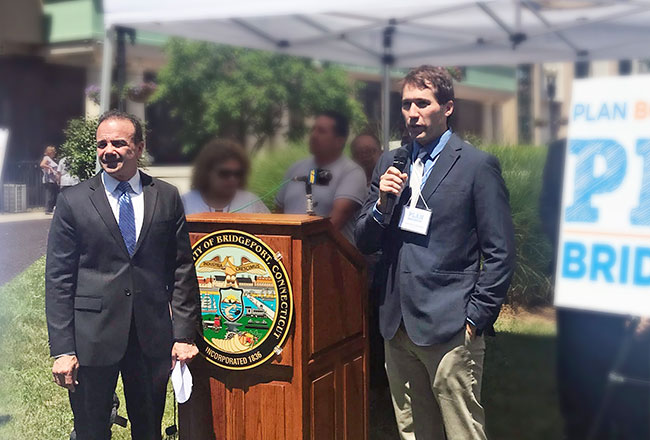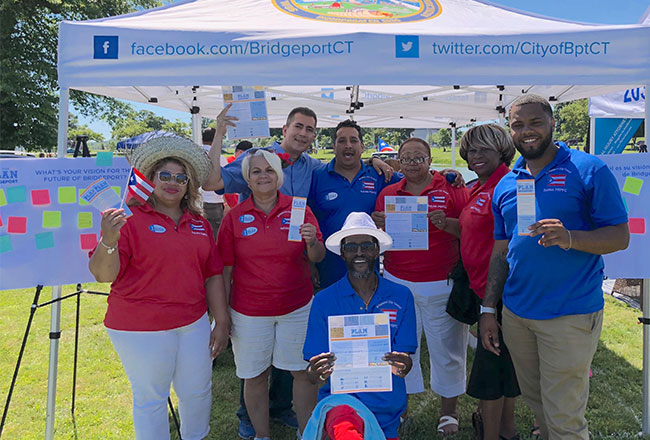Two master plans underway in Bridgeport; return of commercial service to Sikorsky Airport possible

A pair of master plans could, when implemented, significantly change the Bridgeport landscape in the coming years.
The first ”” the 10-year Master Plan of Conservation and Development (POCD) that, by state law, each municipality must prepare or amend and adopt every decade ”” is being put together with what is hoped to be a higher rate of participation by residents than ever before. It is also taking into consideration such issues as building and maintaining socially equitable communities, improving transportation while addressing environmental concerns, and fostering a healthier lifestyle.
The second, potentially more intriguing effort is an in-depth study of what can be done to improve Igor Sikorsky Memorial Airport ”” which could ultimately lead to the return of regular commercial airline service for the first time since the mid-1990s.
Such a move could revolutionize air travel in Fairfield County, whose only significant airport is Danbury Municipal, limited to charter and private planes. Otherwise most travelers go through Bradley International in Windsor Locks; Tweed-New Haven, whose only airline is PSA, a wholly owned subsidiary of American Airlines; Westchester County Airport in White Plains; or LaGuardia and JFK International in New York City.
But customers looking to start booking flights from Sikorsky need to keep their zeal in check, cautioned airport manager Michelle Muoio. While acknowledging that returning commercial service to the airport ”” owned by Bridgeport but located in Stratford ”” “is one of the things we”™ll be looking at,” Muoio said it was only one component of the airport master plan.
After all, she noted, “We haven”™t actually started the process yet, but we will be kicking it off in the very near future.”
The city of Bridgeport has provided $53,632 for the study, with the lion”™s share of funding coming from the Federal Aviation Administration”™s $450,000; Sikorsky itself, which operates at an annual deficit of $500,000, contributed $51,822. Muoio noted that the FAA has also provided $170,435 for a separate noise study at the airport.
The master plan, which Muoio said will take about 18 months to complete, will also look at issues such as drainage, improvements to runway pavements, enhancement of safety and security measures, and how to be more environmentally friendly.
“We want to be a good environmental citizen,” she said, “while looking at different ways to improve the efficiency of the airport and how to maximize its utility.”
Public input will be a key part of the master plan, Muoio added, with surveys, public informational meetings and a website dedicated to further collecting and disseminating data. “Transparency and collaboration are key” to the effort, she said, “much like what the city is doing with its master plan.”

The city”™s POCD project is already well underway, said Bridgeport Director of Planning Lynn Haig. “We”™ve been knee-deep in the process” for the past couple of months, she said, noting the data-gathering stage is being done with Hartford-based planning firm Fitzgerald & Halliday.
With branding (“Plan Bold, Plan Smart, Plan Bridgeport”) and a website, planbridgeport.com — which includes surveys in English and Spanish — already in place, the city is now focusing on pop-up events, focus groups and themed neighborhood meetings. The latter, which began in late August, concentrate on topics such as transportation, economic development, and quality of life; the next one, focused on housing, will take place at 6 p.m. on Sept. 19 at the Geraldine Johnson Elementary School at 475 Lexington Ave.
Being active with “pop-up” presences at events such as the Juneteenth African-American and Caribbean Parade, held on June 9, and the Puerto Rican Parade and Festival, held on July 8 at Seaside Park, also have been key components of the city”™s effort, Haig said.
“Only certain people usually come to community meetings,” she noted. “We thought it was better to implement a strategy where we go to the people throughout the city to get their opinions.”
Project Manager Dean Mack said that the pop-up events are averaging 40-50 people, and that about 600 online surveys have been completed. The first question asked online is about which neighborhood the respondent lives in, Mack said, in an effort to make sure that every constituency”™s voice is heard.
“We want to include the lower-income population, which generally feels underrepresented and underappreciated,” Mack said. “They”™re usually less tech-savvy than in some of our other neighborhoods, so we”™re trying to address that with the pop-up events.”
As to what issues are cited with regularity by citizens, Mack said that typical complaints are being heard about potholes and decaying sidewalks, while Haig said that many respondents appreciate Bridgeport”™s many parks and are hoping they can be expanded.
Affordable housing has emerged as one of the most discussed topics, Haig said. “There are disparate messages ”” a lot of people are moving to Bridgeport from New York and Westchester County because it”™s very affordable. On the other hand, there is a lack of affordable housing for the low-income population that”™s already in the city. That”™s something we want to try and address.”
Data-gathering is scheduled to be completed soon, with drafting of the POCD beginning in October; the final product should be available by year”™s end, Haig said.
She noted that it was always Bridgeport”™s plan to take its master plan beyond street and housing improvements and into areas such as improving health, developing a more resilient economy, and engaging in “responsible regionalism,” whereby the city will explore how to work with neighboring municipalities to share services and resources.
“Most master plans are just a guide for the government,” she said. “We want this to be a guide for everybody in the community.”